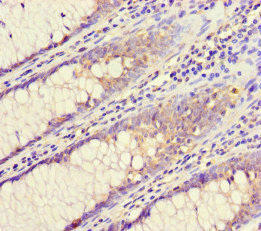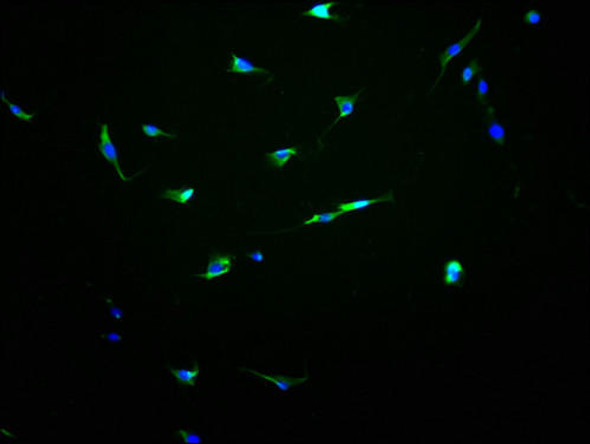Description
| Antibody Name: | CHMP4C Antibody (PACO46994) |
| Antibody SKU: | PACO46994 |
| Size: | 50ug |
| Host Species: | Rabbit |
| Tested Applications: | ELISA, IHC |
| Recommended Dilutions: | ELISA:1:2000-1:10000, IHC:1:20-1:200 |
| Species Reactivity: | Human |
| Immunogen: | Recombinant Human Charged multivesicular body protein 4c protein (1-233AA) |
| Form: | Liquid |
| Storage Buffer: | Preservative: 0.03% Proclin 300 Constituents: 50% Glycerol, 0.01M PBS, PH 7.4 |
| Purification Method: | >95%, Protein G purified |
| Clonality: | Polyclonal |
| Isotype: | IgG |
| Conjugate: | Non-conjugated |
 | Immunohistochemistry of paraffin-embedded human colon cancer using PACO46994 at dilution of 1:100. |
| Background: | Probable core component of the endosomal sorting required for transport complex III (ESCRT-III) which is involved in multivesicular bodies (MVBs) formation and sorting of endosomal cargo proteins into MVBs. MVBs contain intraluminal vesicles (ILVs) that are generated by invagination and scission from the limiting membrane of the endosome and mostly are delivered to lysosomes enabling degradation of membrane proteins, such as stimulated growth factor receptors, lysosomal enzymes and lipids. The MVB pathway appears to require the sequential function of ESCRT-O, -I,-II and -III complexes. ESCRT-III proteins mostly dissociate from the invaginating membrane before the ILV is released. The ESCRT machinery also functions in topologically equivalent membrane fission events, such as the terminal stages of cytokinesis and the budding of enveloped viruses (HIV-1 and other lentiviruses). Key component of the cytokinesis checkpoint, a process required to delay abscission to prevent both premature resolution of intercellular chromosome bridges and accumulation of DNA damage: upon phosphorylation by AURKB, together with ZFYVE19/ANCHR, retains abscission-competent VPS4 (VPS4A and/or VPS4B) at the midbody ring until abscission checkpoint signaling is terminated at late cytokinesis. Deactivation of AURKB results in dephosphorylation of CHMP4C followed by its dissociation from ANCHR and VPS4 and subsequent abscission. ESCRT-III proteins are believed to mediate the necessary vesicle extrusion and/or membrane fission activities, possibly in conjunction with the AAA ATPase VPS4. Involved in HIV-1 p6- and p9-dependent virus release. CHMP4A/B/C are required for the exosomal release of SDCBP, CD63 and syndecan. |
| Synonyms: | Charged multivesicular body protein 4c (Chromatin-modifying protein 4c) (CHMP4c) (SNF7 homolog associated with Alix 3) (SNF7-3) (hSnf7-3) (Vacuolar protein sorting-associated protein 32-3) (Vps32-3) (hVps32-3), CHMP4C, SHAX3 |
| UniProt Protein Function: | CHMP4C: component of the ESCRT-III complex, which is required for multivesicular bodies (MVBs) formation and sorting of endosomal cargo proteins into MVBs. The MVB pathway mediates delivery of transmembrane proteins into the lumen of the lysosome for degradation. The ESCRT-III complex is probably involved in the concentration of MVB cargo. In the ESCRT-III complex, it probably serves as an acceptor for ESCRT-I complex on endosomal membranes. In case of infection, the HIV-1 virus takes advantage of the ESCRT-III complex for budding and exocytic cargos of viral proteins, via the association of CHMP4 proteins with PDCD6IP/AIP1, a protein directly recruited by HIV-1 p6 protein that functions at sites of viral Gag assembly and budding.Protein type: VesicleChromosomal Location of Human Ortholog: 8q21.13Cellular Component: late endosome membrane; midbody; cytosolMolecular Function: protein binding; protein homodimerization activityBiological Process: protein transport; cell separation during cytokinesis; viral reproduction; abscission; vacuolar transport; regulation of viral reproduction; viral infectious cycle; endosome transport; mitotic metaphase plate congression; negative regulation of cytokinesis; nuclear organization and biogenesis |
| UniProt Protein Details: | |
| NCBI Summary: | CHMP4C belongs to the chromatin-modifying protein/charged multivesicular body protein (CHMP) family. These proteins are components of ESCRT-III (endosomal sorting complex required for transport III), a complex involved in degradation of surface receptor proteins and formation of endocytic multivesicular bodies (MVBs). Some CHMPs have both nuclear and cytoplasmic/vesicular distributions, and one such CHMP, CHMP1A (MIM 164010), is required for both MVB formation and regulation of cell cycle progression (Tsang et al., 2006 [PubMed 16730941]).[supplied by OMIM, Mar 2008] |
| UniProt Code: | Q96CF2 |
| NCBI GenInfo Identifier: | 22748643 |
| NCBI Gene ID: | 92421 |
| NCBI Accession: | NP_689497.1 |
| UniProt Secondary Accession: | Q96CF2,B2RBZ1 |
| UniProt Related Accession: | Q96CF2 |
| Molecular Weight: | 26,411 Da |
| NCBI Full Name: | charged multivesicular body protein 4c |
| NCBI Synonym Full Names: | charged multivesicular body protein 4C |
| NCBI Official Symbol: | CHMP4C |
| NCBI Official Synonym Symbols: | Shax3; SNF7-3; VPS32C |
| NCBI Protein Information: | charged multivesicular body protein 4c |
| UniProt Protein Name: | Charged multivesicular body protein 4c |
| UniProt Synonym Protein Names: | Chromatin-modifying protein 4c; CHMP4c; SNF7 homolog associated with Alix 3; SNF7-3; hSnf7-3; Vacuolar protein sorting-associated protein 32-3; Vps32-3; hVps32-3 |
| Protein Family: | Charged multivesicular body protein |
| UniProt Gene Name: | CHMP4C |
| UniProt Entry Name: | CHM4C_HUMAN |






